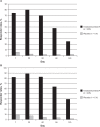Treating glabellar lines with botulinum toxin type A-hemagglutinin complex: a review of the science, the clinical data, and patient satisfaction
- PMID: 20458348
- PMCID: PMC2861845
- DOI: 10.2147/cia.s9338
Treating glabellar lines with botulinum toxin type A-hemagglutinin complex: a review of the science, the clinical data, and patient satisfaction
Abstract
Botulinum toxin type A treatment is the foundation of minimally invasive aesthetic facial procedures. Clinicians and their patients recognize the important role, both negative and positive, that facial expression, particularly the glabellar frown lines, plays in self-perception, emotional well-being, and perception by others. This article provides up-to-date information on fundamental properties and mechanisms of action of the major approved formulations of botulinum toxin type A, summarizes recent changes in naming conventions (nonproprietary names) mandated by the United States Food and Drug Administration, and describes the reasons for these changes. The request for these changes provides recognition that formulations of botulinum toxins (eg, onabotulinumtoxinA and abobotulinumtoxinA) are not interchangeable and that dosing recommendations cannot be based on any one single conversion ratio. The extensive safety, tolerability, and efficacy data are summarized in detail, including the patient-reported outcomes that contribute to overall patient satisfaction and probability treatment continuation. Based on this in-depth review, the authors conclude that botulinum toxin type A treatment remains a cornerstone of facial aesthetic treatments, and clinicians must realize that techniques and dosing from one formulation cannot be applied to others, that each patient should undergo a full aesthetic evaluation, and that products and procedures must be selected in the context of individual needs and goals.
Keywords: botulinum toxin type A; cosmetic; glabellar; onabotulinumtoxinA; patient satisfaction.
Figures






References
-
- Shakespeare W.The Tragedy of MacbethAct 1, scene 4, line 13.
-
- Lewis MB, Bowler PJ. Botulinum toxin cosmetic therapy correlates with a more positive mood. J Cosmet Dermatol. 2009;8(1):24–26. - PubMed
-
- Ekman P. Facial expression and emotion. Am Psychol. 1993;48(4):384–392. - PubMed
-
- Heckmann M, Teichmann B, Schroder U, Sprengelmeyer R, Ceballos-Baumann AO. Pharmacologic denervation of frown muscles enhances baseline expression of happiness and decreases baseline expression of anger, sadness, and fear. J Am Acad Dermatol. 2003;49(2):213–216. - PubMed
-
- Strack F, Neumann R. Furrowing the brow may undermine perceived fame: the role of facial feedback in judgments of celebrity. Pers Soc Psychol Bull. 2000;26(7):762–768.
Publication types
MeSH terms
Substances
LinkOut - more resources
Full Text Sources
Other Literature Sources
Medical

